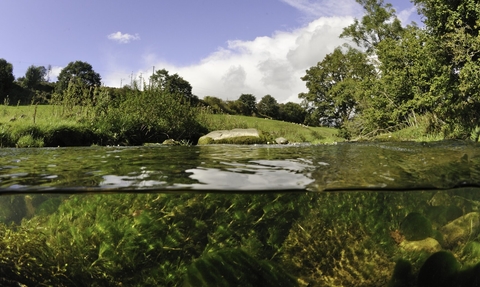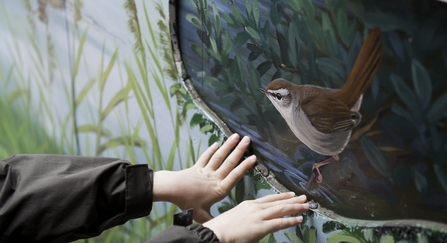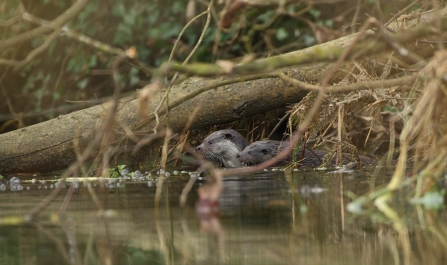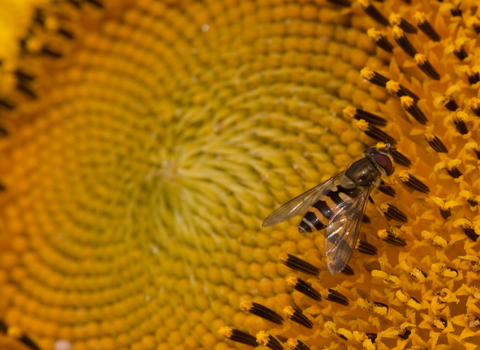
Split level view of the River Leith, with aquatic plants: Water-crowfoot (Ranunculus penicillatus subsp. penicillatus) England: Cumbria, Eden Valley, Great Strickland, September © Linda Pitkin/2020VISION
Cumbria Local Nature Partnership (CLNP)
What is the Cumbria Local Nature Partnership?
The Cumbria Local Nature Partnership (CLNP) was officially recognised and confirmed by Government in 2012 (under the Natural Environment White Paper 2011) with the purpose of acting as the “prominent and unified voice for the natural environment in Cumbria” and “to foster the development of a strategic natural environment framework for the county”.
It's one of c. 50 Local Nature Partnerships across England. The CLNP is the only nature partnership which represents and works across the whole of Cumbria; acting as a hub for nature - focused planning and action. Its functions include:
- Acting as an advocate for the natural environment in Cumbria;
- Coordinating delivery for the natural environment;
- Acting as a forum for the stakeholders in Cumbria’s natural environment;
- Providing input on the natural environment for local policies, plans and frameworks;
- Providing information/data on the natural environment.
Which organisations are involved in the Cumbria Local Nature Partnership?
Cumbria Local Nature Partnership consists of a wide range of organisations including:
• statutory agencies
• environmental organisations
• local authorities, National Park Authorities and AONB
• representatives of farming and landowning interests
• research and educational institutions
• businesses, voluntary organisations and community groups
The work of the CLNP is overseen and co-ordinated by a Board (see membership) and an independent Chair, and supported by a Partnership Manager.
The Cumbria Local Nature Partnership's vision for the environment of Cumbria is:
“Cumbria is a place where consideration for the environment informs every decision making process and where the environment is managed to provide a wide range of benefits for nature, people and the economy. In Cumbria nature’s role within the landscape is understood and valued by all”.
Framework for Future Action
The Partnership’s “Framework for Future Action” outlines five themes on which CLNP and others need to work in order to realise this vision:
1. Nature Recovery
Provide leadership, co-ordination and support to the development and delivery of the Local Nature Recovery Strategy
- Identify priorities and operationalize opportunities for partnership delivery against LNRS objectives
- Maintain a portfolio of collaborative projects and host specific projects as appropriate
2. Green Growth
Work with the LEP and other partners to ensure that development supports nature, including developing a local approach to environmental net gain
- Develop a shared local approach to natural capital investment and work with the LEP to develop opportunities
- Understand the green finance/alternative finance landscape in Cumbria – be clear who is testing what and where
- Support existing green finance initiatives
- Identify and harness opportunities to apply green finance to optimise the right nature recovery in the right places (aligning with the LNRS)
3. Natural Climate Solutions
Work with Zero Carbon Cumbria to co-ordinate nature-based solutions to climate change reduction and mitigation of impact
- Identify and operationalize opportunities for partnership delivery
- Develop a portfolio of collaborative projects and host specific projects as appropriate
4. Knowledge and Skills
Identify gaps in our knowledge base and establish mechanisms for filling these
Identify where skills development is required to take forward other themes
- Improve the natural environment evidence-base, its management and accessibility
- Promote and develop investment in training and improving awareness
5. Natural Health Service
Develop a plan for encouraging participation in the natural world, particularly targeted at those in urban and more deprived areas
- Develop opportunities for natural social prescribing
- Connect with communication planning to encourage uptake of participation opportunities

© Paul Harris/2020VISION
Over the coming year the CLNP will be focusing its effort on driving forward ‘Nature Recovery’ in Cumbria, and in particular supporting the preparation and then delivery of Cumbria’s Local Nature Recovery Strategy. By doing this we aim to make the creation of a Nature Recovery Network a reality.
Cumbria’s Nature Recovery Network
Cumbria has an amazing range of landscapes and geology, supporting a diverse and rich wildlife. However, despite considerable amounts of work by land managers, and some great wildlife success stories, we continue to witness the decline of nature in Cumbria as climate change, development pressure, land management and modern-day life impact on our natural environment.
Once common species have become rare and wildlife habitats have been lost, degraded or fragmented. We rely on our natural systems to provide essentials such as food, clean air and water, and it also underpins the quality of our lives by supporting health, recreation and fulfilment.
It is essential that we restore our natural environment, bringing back habitats and species we have lost and ensuring that we pass on a healthy and vibrant natural environment, and the wildlife it supports, to future generations.
Our vision for Nature Recovery in Cumbria (PDF) is aligned with that of the developing Cumbria Local Nature Recovery Strategy:
“Cumbria’s wildlife in rural, urban and coastal places will be actively looked after and treasured. Healthy ecosystems on land and sea will support a sustainable local economy valued for its natural assets and contribute to the wellbeing of residents and visitors.”
The development of a Nature Recovery Network (NRN) is a major commitment in the government’s 25 Year Environment Plan and enacted by the Environment Act 2021. Partners, legislation, and funding need to work together to create the NRN - a national network of wildlife-rich places connected across our cities, towns, countryside and coast. This will be delivered through:
- Local Nature Recovery Strategies (LNRS) which will align local priorities and national need and will help to effectively target action for nature.
- Strong partnerships to deliver action on the ground including local government, landowners/managers, business, local communities and conservation organisations.
- Integration of policies and funding streams to maximise opportunities for nature recovery and secure new funding (public and private). This includes effective application of policies such as Biodiversity Net Gain and new farming incentives.
Although the Nature Recovery Network will become a physical network on the ground, with healthy habitats, rivers, lakes and coast, its vision and approach will be expressed and prioritised through the Local Nature Recovery Strategy.
Cumbria’s Local Nature Recovery Strategy (LNRS)
Local Nature Recovery Strategies (LNRS) are a new mandatory system of spatial strategies for nature established by the Environment Act 2021. They are designed to encourage and help the public, private and voluntary sectors deliver more coordinated practical and focused action and investment in nature.
For each area that they cover, LNRS will agree priorities for nature’s recovery, map the most valuable existing habitat for nature, and map specific proposals for creating or improving habitat for nature and wider environmental goals. Key to achieving this will be creating genuine local collaboration with a partnership of organisations and individuals working closely with each “responsible authority”.
Westmorland and Furness Council are acting as the “responsible authority” (appointed by the Defra Secretary of State), for a Cumbria-wider LNRS, however as this is expected to be a collaborative approach with Cumberland Council and the two National Parks. Working with land managers/owners, business, local communities and organisations this will provide a locally owned strategy to support the creation of a Nature Recovery Network.
This is in turn will help achieve wider environmental objectives (like carbon sequestration to mitigate climate change or managing flood risk) and contribute to green economic recovery objectives.

Otter and otter cub in a river © Luke Massey/2020VISION
Documents:
Cumbria Local Nature Recovery Partnership (CLNP) Nature Recovery Network (NRN) paper (pdf)
Partner/Partnership websites:
Council plan | Westmorland and Furness Council
About your council | Cumberland Council
UK's Largest Woodland Conservation Charity - Woodland Trust
Find out about the NFU – NFU online
Environment Agency - GOV.UK (www.gov.uk)
Natural England - GOV.UK (www.gov.uk)
Discover the UK's natural environment | National Trust
Cumbria’s Rivers Trusts:
Archived documents:
Cumbria Local Nature Partnership Strategy 2015-2022 document (pdf)
Cumbria Local Nature Recovery Summary document (pdf)
Further information
If you'd like to find out more about the CLNP and its work, please email Jody Ferguson, Cumbria Local Nature Partnership Manager.

